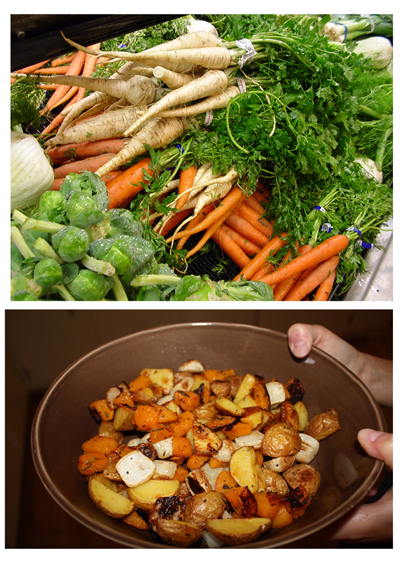by Alyson Walls of eat local pittsburgh
Full of vitamins A and C and rich in earthy flavor, root vegetables like carrots, sweet potatoes, beets, turnips, rutabagas and parsnips provide the perfect base for hearty fall soups and stews or a simple roasted accompaniment to meats like chicken and pork. Root vegetables are the starchy tubers and taproots of plants that grow underneath the soil. Of course, the most popular root vegetables we think of are carrots and potatoes, but these only scratch the surface. Don’t be afraid to experiment with a variety of root vegetable recipes: try adding the foot-long daikon radish to a salad or stir-fry, or mash some jicama instead of traditional potatoes. Root vegetables such as turnips and sweet potatoes typically have fewer carbohydrates than traditional potatoes, and can be a healthier option. Don Leskanic, an executive chef with Cura Hospitality, says root vegetables — which originated in the cool climates of Europe — will be coming into season over the next few weeks. Root vegetables can be grown up until the first killing frost, usually around late October or early November, and can be stored in the refrigerator or old-fashioned root cellar, for up to 30 days. These versatile veggies also freeze well, and are tasty when mashed, roasted with olive oil and fresh herbs or cooked in a healthy vegetable soup.
Chef Don, says root vegetables taste best when combined together. Mash some turnips in with regular potatoes, or pair rutabagas with carrots. For fresh, locally grown root vegetables like parsnips and carrots, Chef Don says you can save some time and effort by not peeling them. Simply scrub well with water and a hard brush and cook away. But root vegetables sold in grocery stores are usually coated in wax which needs to be peeled away.Here are a few ways to enjoy root vegetables courtesy of Molly Watson at About.com:
Mashed Root Vegetables
Mashed potatoes are well known, as are mashed sweet potatoes (often sweetened with brown sugar). Bu other root vegetables like parsnips, turnips, and celery root are also delicious mashed – either on their own or together with traditional potatoes.
1. Scrub and peel root vegetables and cut into large, even chunks. Put them in a pot and cover with cold water.
2. Bring to a boil. Add salt. Cook until vegetables are very tender, about 20 minutes.
3. Drain thoroughly; return vegetables to pot over low heat.
4. Mash with a large fork or masher. Add cream, butter, milk, and/or buttermilk and salt and pepper to taste. Serve hot.
Root Vegetable Soups
Root vegetables add flavor, nutrition, and bulk to soups and stews. When cut into bite-size pieces most root vegetables take about 20 minutes to become tender when boiled, so add them towards the end of cooking time to avoid mushy vegetables. Or, shred them on a large-holed grater to have them blend in a bit. Chicken or vegetable stock provides a good base.
Roasted Root Vegetables
Roasting brings out the essential sweetness in root vegetables and creates a beautiful and crispy brown exterior. Plus, it’s EASY.
1. Scrub vegetables clean; peel if you like.
2. Cut vegetables into bite-size pieces.
3. Toss vegetables with enough olive oil, vegetable oil, or melted butter to lightly but evenly coat them.
4. Put vegetables in a roasting or baking pan, sprinkle with salt. Sprinkle with freshly ground black pepper, chopped herbs, or spices (such as cayenne) to taste.
5. Roast in a hot oven (375 to 425) until vegetables are tender and browned, about 30 minutes.
6. You can roast vegetables with chicken or a meat; add them to the pan about half an hour before you expect the meat to be cooked.

